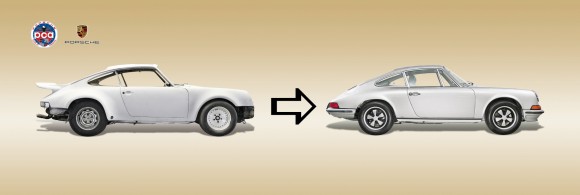 911 T Coupe US version (1973): Fully restored classic awaits new owner
911 T Coupe US version (1973): Fully restored classic awaits new owner
Thanks to the “Revive the Passion” project, a US version 911 T Coupe from the year 1973 is one of the main attractions at this year’s Porsche Parade organized by the Porsche Club of America (PCA). As part of the festival week for all Porsche enthusiasts in Savannah, Georgia, from July 31 to August 7, the fully restored classic will be raffled off among PCA members and handed over to its new owner. The outstanding feature of this project is the fact that all fans and enthusiasts of Porsche classic vehicles were able to follow the restoration of the vehicle on the Internet (www.porsche.com/classic).
The winner can look forward to becoming the proud owner of a collector’s item of great value. This is because the 911 T has been restored to its former glory by the experts at Porsche Classic in its home city of Stuttgart, where it was originally produced for the US market. “Made in Germany” for the second time – after 38 years.
The idea for “Revive the Passion” was born during the “Rennsport Reunion” in Daytona in 2007. During a conversation, representatives of the PCA, Porsche Club Service and Porsche Classic took the decision to offer an attractive Porsche classic car instead of a new vehicle in the traditional PCA raffle. A suitable car was found near Los Angeles and was subsequently presented to club members at the Porsche Parade 2010 in St. Charles, Illinois, in its then rather pitiful condition. The 911 T then went on a journey to Stuttgart, where the experts at Porsche took care of the vehicle.
The US version 911 T Coupe originates from the last year of production of the so-called F model. It features an air-cooled flat-six engine with a displacement of 2.4 liters and a power output of 103 kW (140 hp) at 5,600 rpm. Its top speed is 127 mph (205 km/h). This Porsche is characterized by its narrow body and is finished in the classic color combination Silver Metallic (exterior) and Black (interior). Paul Gregor from the Porsche Club Service: “The body form, color combination and year of production make this vehicle especially popular among collectors and ensure good value retention.”
However, there was not much of this to be seen before the start of restoration. The specialists in the Porsche Classic workshop received a vehicle without headlights or windows. The paint had peeled off and numerous parts, some even “home-made”, were not from the original vehicle equipment. In addition, there were many defects in the interior. Nothing is known to the present day about the history of the vehicle and the long period out of service meant that the vehicle was clearly suffering from the ravages of time. The remains of bird’s nests were even found in the underbody.
Fans and enthusiasts were able to follow the transformation of the classic vehicle into a collector’s item from close up. “We regularly reported about the progress of the full restoration on our website, supplemented with numerous pictures and film material of the individual work steps,” says Barbara Böckenhoff, who is responsible for project coordination at Porsche Classic. PCA members also received updates through the club’s online newsletter. In this way, Porsche Classic was able to demonstrate its outstanding expertise and its ideal factory restoration facilities to customers in the USA in particular – with more than 100,000 members, the PCA is the largest Porsche Club in the world. In the Porsche Classic workshop close to Stuttgart, work is carried out only with original tools, original parts (or parts reproduced on the basis of original drawings) and using original data and dimensions. Alexander Fabig, Head of Porsche Classic: “Every year we service and restore around 250 Porsche classic cars from all over the world, from the 356 through to the last air-cooled 911 model, the Type 993.”
Work on the 911 T took just under a year, from complete disassembly through to complete transformation. Right down to the very last screw, there was no part that did not pass through the hands of the experts at Porsche Classic to be checked, refurbished or replaced. For the extensive body work, the mechanics used either original parts or parts reproduced on the basis of the original documentation. In contrast, the latest methods were used to treat the body for corrosion protection. Electrophoretic dip coating is a standard process in the automotive industry. It guarantees optimum priming of the bodyshell and is therefore also used during complete restoration of vehicles at Porsche Classic. The experts at Porsche Classic have also moved with the times in terms of paints and therefore use only water-based multiple-coat paints for environmental reasons. As part of final acceptance, the vehicle was also subjected to stringent function and performance tests, using methods from current production in some cases.
The 911 T Coupe now shines again in its former glory and exudes the sporty charm of the 70s. Whether it is too valuable to move or too beautiful to be admired only standing still is something that the new owner must decide. The chances are that the temptation to drive the 911 T will just be too great.
Source: Porsche
Photo: Porsche/9Magazine




